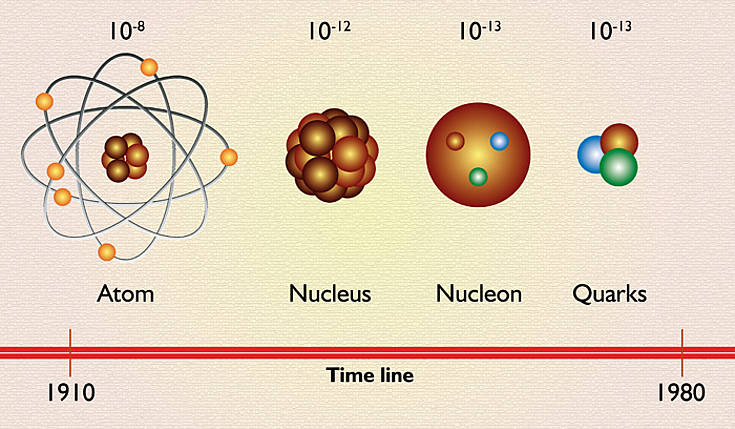What if you could peel back the layers of matter, delving into an intricate world that defies the simplicity of everyday observations? The atom, long acknowledged as the fundamental building block of all matter, is not as elementary as one might surmise. At its heart, more specifically within its nucleus, lies a bewilderingly complex ensemble of subatomic particles, the most elusive of which are quarks. But what are quarks, and how do they contribute to the fabric of the universe?
To comprehend the essence of quarks, one must first revisit the structure of an atom. Traditionally, an atom consists of a central nucleus surrounded by a cloud of electrons. The nucleus contains protons and neutrons, which are, in turn, composed of quarks. This revelation leads to an intriguing inquiry: if quarks are foundational elements of protons and neutrons, can one truly consider atoms as the smallest indivisible units of matter?
Quarks are elementary particles, fundamental constituents within the realm of particle physics. They are the building blocks of hadrons—subatomic particles formed from quark combinations. Notably, the two most prevalent types of hadrons are baryons, such as protons and neutrons, which contain three quarks, and mesons, which are composed of a quark and an antiquark pair. This duality emphasizes the multifaceted nature of quarks in constructing the atomic nucleus and illustrates how they embody the principles of quantum chromodynamics (QCD), the theory that describes the strong interaction, one of the four fundamental forces of nature.
Quarks are characterized by a unique set of properties, including their electric charge, color charge (not related to visual color), mass, and spin. There are six flavors of quarks, each possessing distinctive attributes: up, down, charm, strange, top, and bottom. Within the context of protons and neutrons, the up and down quarks are the most consequential. A proton is composed of two up quarks and one down quark, giving it a total charge of +1. Conversely, a neutron is made up of two down quarks and one up quark, resulting in a neutral charge. This precise arrangement underscores the intricacies of flavor combinations and their implications for understanding atomic stability and behavior.
The concept of color charge in quarks is integral to their interactions. Each quark carries one of three “colors”—red, green, or blue—terms that merely serve as fun labels without any actual color association. When quarks combine to form hadrons, they do so in a manner that ensures color neutrality, analogous to mixing primary colors to create white light. This characteristic is essential for the strong force mediated by gluons, which are the force carriers that bind quarks together within protons and neutrons, contrasting with the electromagnetic force that governs interactions between charged particles.
One may wonder how these minuscule entities hold the structural integrity of matter together despite the immense repulsive forces that act between positively charged protons. The answer lies in the strength of the strong nuclear force, which operates at a much shorter range than electromagnetic forces but is incredibly powerful. It is the interplay of quarks, gluons, and the dynamics of QCD that facilitate the formation of stable atomic nuclei, ultimately allowing the universe to coalesce into structures ranging from stars to galaxies.
Yet, challenges abound in the exploration of quarks. One significant issue concerns the confinement of quarks: they have never been found in isolation. This phenomenon poses a theoretical enigma, leading to the hypothesis that quarks are perpetually bound within hadrons due to the escalating strength of the strong force as quarks attempt to separate. This confinement is a fundamental aspect of QCD, and research continues to deepen our understanding of its implications for particle physics and cosmology.
In recent years, experimental physicists have endeavored to elucidate the behavior of quarks using particle colliders, such as the Large Hadron Collider (LHC). These high-energy collisions result in conditions similar to those just after the Big Bang, allowing particles to briefly exist in a quark-gluon plasma state. Understanding this state can provide insights into the early universe and the conditions that led to the formation of matter as we know it.
The dynamic nature of quarks and their interactions underscores a broader context—the emergence of complex phenomena from simple constituents. While quarks may appear as mere specks in the universe’s grand tapestry, they play a monumental role in shaping the interactions that govern matter. Interested observers may ponder the cascade of complexity that arises from these humble origins. As one delves deeper into the subatomic realm, it becomes increasingly evident that each layer exposed reveals even greater mysteries awaiting exploration.
In conclusion, quarks are not merely theoretical constructs; they represent the very essence of matter within the universe. By investigating quarks, physicists wrestle with profound questions about the fundamental nature of reality and the forces that shape our world. What adventures lie ahead in the quest to comprehend these elusive particles? Through continued research and discovery, the narrative of quarks will undoubtedly evolve, paving the way for new understandings and revolutionary ideas in the annals of physics and beyond.












